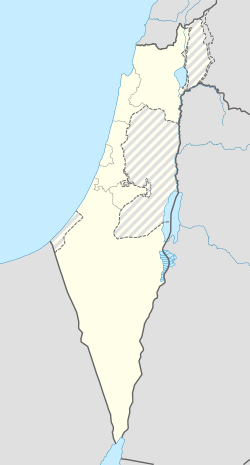Top Qs
Timeline
Chat
Perspective
2015 UEFA Women's Under-19 Championship
International football competition From Wikipedia, the free encyclopedia
Remove ads
The 2015 UEFA Women's Under-19 Championship was the 14th edition of the UEFA Women's Under-19 Championship (18th edition if the Under-18 era is included), the annual European youth football competition contested by the women's under-19 national teams of the member associations of UEFA. Israel hosted the tournament.[1] Players born on or after 1 January 1996 were eligible to participate in this competition.
Same as previous editions held in odd-numbered years, the tournament acted as the UEFA qualifiers for the FIFA U-20 Women's World Cup. The four semi-finalists qualified for the 2016 FIFA U-20 Women's World Cup in Papua New Guinea as the UEFA representatives.[2]
Remove ads
Qualification
Summarize
Perspective
A total of 48 UEFA nations entered the competition, and with the hosts Israel qualifying automatically, the other 47 teams competed in the qualifying competition to determine the remaining seven spots in the final tournament. The qualifying competition consisted of two rounds: Qualifying round, which took place in autumn 2014, and Elite round, which took place in spring 2015.[3]
Qualified teams
The following eight teams qualified for the final tournament.[4][5]
Note: All appearance statistics include only U-19 era (since 2002).
Notes
- ^ The best runners-up among all six elite round groups qualified for the final tournament.
Final draw
The final draw was held in Haifa, Israel on 20 May 2015, 20:15 IDT (UTC+3).[6][7] The eight teams were drawn into two groups of four teams. There were no seeding except that the hosts Israel were assigned to position A1 in the draw.
Remove ads
Venues
The matches were played at four venues in four host cities.[8]
Squads
Each national team had to submit a squad of 18 players.[3]
Sweden
- Head coach: Calle Barrling
- Goalkeepers: Matilda Haglund (Lidköpings FK), Emma Holmgren (IK Sirius)
- Defenders: Ronja Aronsson (Piteå IF), Lotta Ökvist (Piteå IF), Nathalie Björn (AIK), Emelie Andersson (QBIK), Julia Ekholm (Bollstanäs SK)
- Midfielders: Filippa Angeldahl (AIK), Anna Oskarsson (Hammarby IF), Tove Almqvist (Linköpings FC), Michelle De Jongh (KIF Örebro DFF), Maja Göthberg (Hovås Billdal IF), Emma Jansson (Hammarby IF), Ellen Löfqvist (Sundsvalls DFF)
- Forwards: Julia Zigiotti Olme (AIK), Stina Blackstenius (Linköpings FC), Rebecka Blomqvist (Kopparbergs/Göteborg FC), Linda Hallin (KIF Örebro DFF)[9]
Match officials
A total of 6 referees, 8 assistant referees and 2 fourth officials were appointed for the final tournament.[10]
|
|
|
Remove ads
Group stage
Summarize
Perspective
Group winners and runners-up advanced to the semi-finals and qualified for the 2016 FIFA U-20 Women's World Cup.
- Tiebreakers
if two or more teams were equal on points on completion of the group matches, the following tie-breaking criteria were applied, in the order given, to determine the rankings:[3]
- Higher number of points obtained in the group matches played among the teams in question;
- Superior goal difference resulting from the group matches played among the teams in question;
- Higher number of goals scored in the group matches played among the teams in question;
- If, after having applied criteria 1 to 3, teams still had an equal ranking, criteria 1 to 3 were reapplied exclusively to the group matches between the teams in question to determine their final rankings. If this procedure did not lead to a decision, criteria 5 to 9 applied;
- Superior goal difference in all group matches;
- Higher number of goals scored in all group matches;
- If only two teams had the same number of points, and they were tied according to criteria 1 to 6 after having met in the last round of the group stage, their rankings were determined by a penalty shoot-out (not used if more than two teams had the same number of points, or if their rankings were not relevant for qualification for the next stage).
- Lower disciplinary points total based only on yellow and red cards received in the group matches (red card = 3 points, yellow card = 1 point, expulsion for two yellow cards in one match = 3 points);
- Drawing of lots.
All times were local, IDT (UTC+3).
Group A
Group B
Source: UEFA
Notes:
Notes:
Remove ads
Knockout stage
Summarize
Perspective
In the knockout stage, extra time and penalty shoot-out were used to decide the winner if necessary.[3]
Bracket
| Semi-finals | Final | |||||
| 24 July – Lod | ||||||
| 1 (4) | ||||||
| 27 July – Netanya | ||||||
| 1 (5) | ||||||
| 1 | ||||||
| 24 July – Netanya | ||||||
| 3 | ||||||
| 3 (2) | ||||||
| 3 (4) | ||||||
Semi-finals
Final
Remove ads
Goalscorers
- 6 goals
- 3 goals
- 2 goals
- 1 goal
- Own goals
 Rebecca Knaak (playing against Norway)
Rebecca Knaak (playing against Norway) Rocío Gálvez (playing against Germany)
Rocío Gálvez (playing against Germany) Emelie Andersson (playing against France)
Emelie Andersson (playing against France)
Source: UEFA.com[11]
Remove ads
Team of the tournament
|
|
Source: UEFA.com[12]
Golden player: ![]() Stina Blackstenius[13]
Stina Blackstenius[13]
Qualified teams for FIFA U-20 Women's World Cup
The following four teams from UEFA qualified for the FIFA U-20 Women's World Cup.[14]
- 1 Bold indicates champion for that year. Italic indicates host for that year.
References
External links
Wikiwand - on
Seamless Wikipedia browsing. On steroids.
Remove ads



